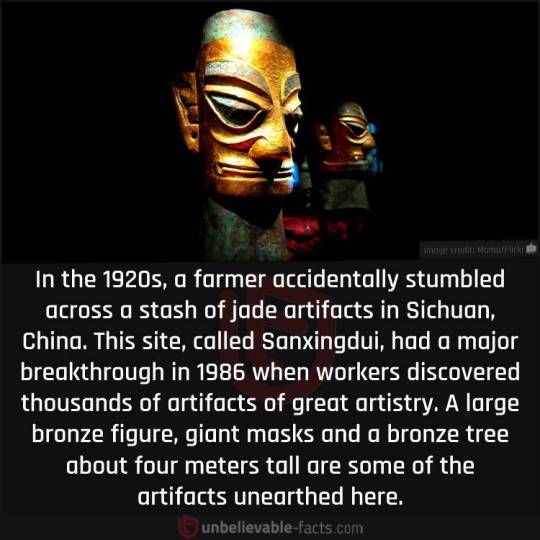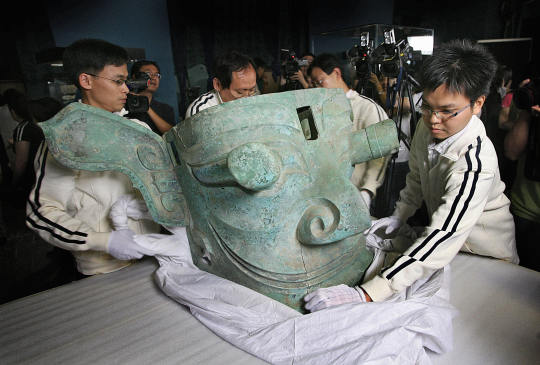#Sanxingdui
Text
BLOOD MOON
by Zhelong Xu



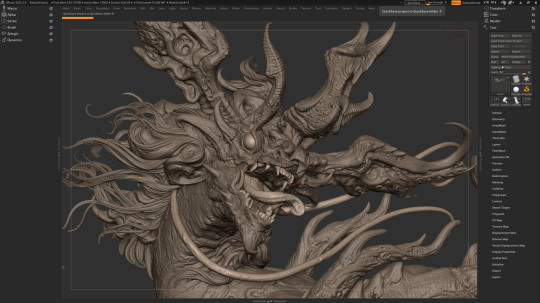
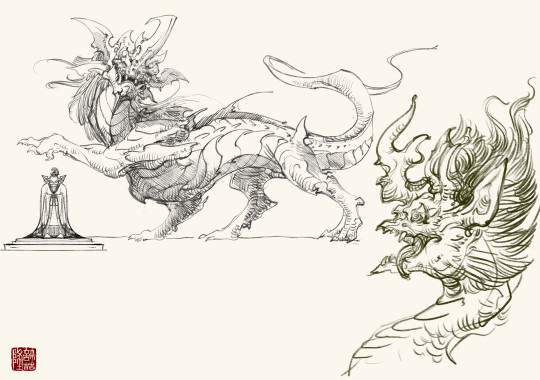
#fhtagn#tentacles#zhelong xu#concept art#sanxingdui#nvidia omniverse#shu#dragon#zbrush#substance#sculpture#creature#monster#horror#fhtagnnn
143 notes
·
View notes
Text

‘Faces of Sanxingdui’: Bronze Age Relics Shed Light on Mysterious Ancient Kingdom
A golden face with patinaed turquoise eyes stares out of the darkness. Illuminated around it stand three other bronze heads — some have flat tops, others round — all looked over by a giant bronze statue almost 9 feet high. All have the same piercing, angular eyes.
There’s something about the “Faces of Sanxingdui” — as this collection of sculptures is being billed — that feels both familiar and alien. Currently on display at the Hong Kong Palace Museum, they may appear Mayan or Aztec to the untrained eye, but these over-3,000-year-old sculptures weren’t unearthed anywhere near Mesoamerica’s ancient civilizations. They were discovered on China’s Chengdu Plain, at an archeological dig site called Sanxingdui (which translates as “three star mound”).
Thought to be the largest and oldest site left by the Shu kingdom, a civilization in southwestern China once only hinted at in myths and legends, Sanxingdui was not discovered until the 1920s, when a farmer stumbled across objects while digging an irrigation ditch. The site has since been found to contain the ruins of an ancient city made up of residences, sacrificial pits and tombs enclosed by high dirt walls. Archaeologists from the Sanxingdui Museum say the city was established some 4,800 to 2,800 years ago, until it was abandoned around 800 BC for unknown reasons.

The Chinese government has long promoted Sanxingdui as evidence of the country’s long, uninterrupted history — with the discoveries included in history textbooks for more than a decade. And while thousands of visitors have already flocked to the groundbreaking exhibition in Hong Kong, some analysts suggest that the items are also being used to support the Chinese government’s vision of national identity.
The mysterious and talented Shu
The Shu kingdom, which emerged in the Sichuan basin during the Bronze Age, is believed to have developed independently of the Yellow River Valley societies traditionally considered the cradle of Chinese civilization. Its inhabitants created exquisitely crafted bronze, jade, gold and ceramic objects, depicting fantastical beasts, kings, gods and shamans with bulging eyes and enlarged ears.
Around 120 of the items are currently on display in Hong Kong, and it’s the first time many of these objects, most of which were excavated between 2019 and 2022, have been showcased outside Sichuan province.

Remarkably, the sculptures predate the Terracotta Army, a collection of earthenware statues depicting the armies of China’s first emperor Qin Shi Huang, by at least 1,000 years. Wang Shengyu, an assistant curator at the Palace Museum said the objects are far more advanced, imaginative, and artistic than those being produced anywhere else in China at that time.
“You can tell that it’s very sculptural and very artsy,” Wang said at the exhibition opening, pointing to a roughly 1-foot-tall bronze figure whose fantastical, braided hair extends out to three times the height of its body and, had it not been broken, would stretch much further. “You can imagine how magnificent it was. From above his nose and all the way up, it would’ve been over 1.5 meters (4.9 feet) tall, according to the fragments (archeologists) found. The end of the pigtail is on his shoulder.”
Little is known about the Shu kingdom other than what’s been discovered on the 3.6-square-kilometer (1.4-square-mile) site outside Chengdu. There is no evidence of a written Shu language, and historical literature contains scant information about its culture other than a handful of myths and legends, including a reference to a Shu king called Can Cong whose eyes were said to have protruded — perhaps explaining why so many of the 13,000 relics recovered from the site feature bulging eyes.

After the Shu state was conquered by the Qin dynasty in 316 BC, Shu culture was “buried” under the “mainstream” culture that later emerged on China’s central plain, Chinese authorities wrote in a 2013 UNESCO submission seeking to have Sanxingdui and two nearby archeological sites recognized as World Heritage Sites. They are currently on UNESCO’s “tentative list.”
Since 1986, eight excavated pits at Sanxingdui have yielded giant masks of gods with bulbous, insect-like eyes and protruding ears, mythical creatures with gaping mouths and an almost 4-meter-tall (13-foot) bronze “tree of life” sculpture decorated with ornaments like a Christmas tree. All the items were found shattered, burned and buried, leading experts to believe the pits were used for ritual sacrifices. Some have now been painstakingly re-constructed by archaeologists. “It took 10 years to reconstruct the tree,” said Wang Shengyu, an assistant curator at the museum who helped curate the exhibition.
That tree is not on show in Hong Kong, as it is considered too precious to send abroad, but a section of one of six others discovered and ornaments are on display at the museum, as well as a 3D holographic projection of what experts think it would have looked like – its layers and branches adorned with birds, flowers, fruit, dragons, bells as well as jade and gold foil ornaments. The set are thought to have been part of a theater space.
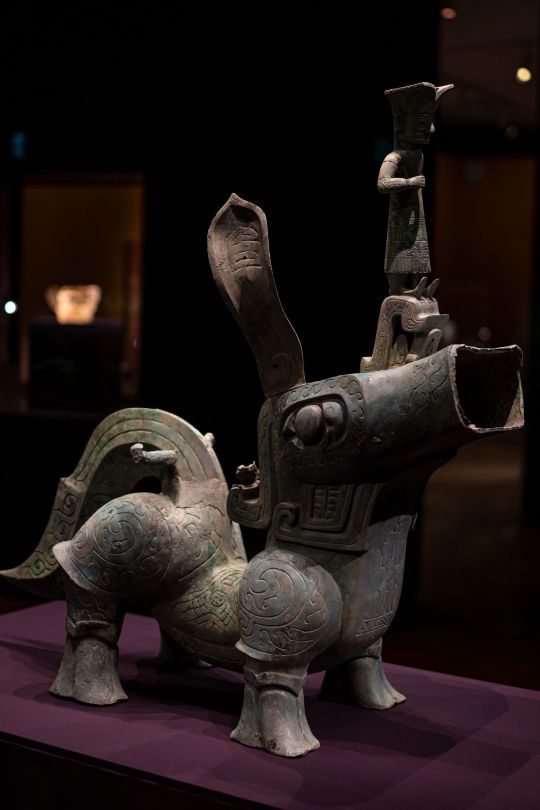
‘Historical myth’ of a continuous civilization
The exhibition places these items in the context of other ancient civilizations and includes the Shu among the many societies to have existed in the country’s “5,000-year history.” According to a press release from organizers, museum and Hong Kong government officials at the opening stressed the “continuity, inventiveness, unity, inclusiveness and emphasis on peace and harmony” of Chinese history.
Henry Tang, chairman of the governing body behind the West Kowloon Cultural District (where the Palace Museum is located) and a former candidate for Hong Kong’s top leadership role, said in a statement that the district and museum are looking to “promote cultural and artistic exchanges between China and the world, ‘tell China’s story well’, and strengthen the public’s cultural self-confidence.”
But the narrative that the Shu kingdom was innately Chinese is contentious, according to Ian Johnson, a senior fellow for China Studies at US think tank, the Council on Foreign Relations.
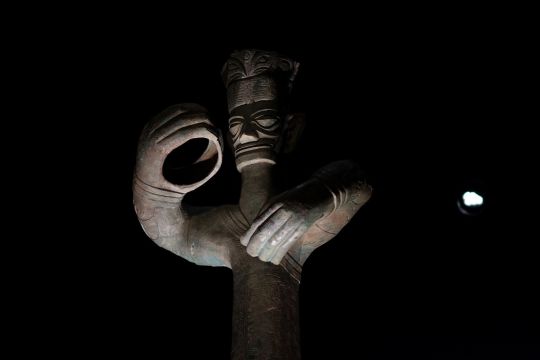
“Over the past few decades, the (Chinese Communist Party) has been trying to push a historical myth that all the peoples who have ever lived inside the current borders of the People’s Republic are ‘Chinese,’” he said over email.
“The basic idea is that the PRC (People’s Republic of China) encompasses people who naturally belong together and therefore, from today’s standpoint, form a nation. Hence any effort to have autonomy or even independence is taboo — it runs against history.”
The People’s Republic of China was established in 1949, and its government has often used China’s continuous history as evidence that ethnic groups such as the Tibetans and the Uyghurs have always belonged to China.

Johnson said that there was little support for the idea that civilizations along the Yellow River had much in common with those in the Sichuan Basin.
“They have commonalities but are not the same — just as ancient Assyrians and Phoenicians and Greeks weren’t the same, even if they shared certain things in common,” he said, adding: “sponsoring these kinds of exhibitions are popular and win the government credit.”
When asked to comment, the Hong Kong Palace Museum said the exhibition was “curated based on academic and archaeological research” and that it reinforces its mission to deepen audiences’ “understanding of the lives and cultures of various regions and ethnic groups as well as exchanges among them in ancient China, which have contributed to the magnificence of China’s civilization and its ‘diversity in unity’ pattern of development.”
By Christy Choi.
#‘Faces of Sanxingdui’: Bronze Age Relics Shed Light on Mysterious Ancient Kingdom#Chengdu Plain#Sanxingdui#Shu kingdom#gold artifacts#bronze artifacts#ancient artifacts#archeology#archeolgst#history#history news#ancient history#ancient culture#ancient civilizations#ancient china#ancient chinese#chinese history#chinese art#long post#long reads
31 notes
·
View notes
Text

47 notes
·
View notes
Text
SANXINGDUI MUSEUM COLLAB MY BELOVED???? Zhongli will never beat the lore allegations like "Gazing up at eternity, Looking down at the world" WHAT DOES IT MEANNNNN
ALSO WE SEE HIS EYES???
i love lore
14 notes
·
View notes
Text
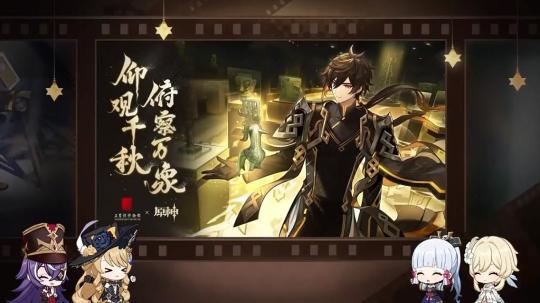
genshin collaboration with sanxingdui museum. zhongli skin when. it clearly exists.
here's an article i found that goes a little more into detail about the collab (disclaimer: it's in chinese)
basically there's nothing officially revealed yet and it's probably able to be boiled down to a big marketing campaign for genshin and sxd to promote and educate people about chinese history
this is not the first time that the sxd museum has collaborated with a video game, so it doesn't seem as weird now but to someone who didn't know about the first collab this came completely out of left field
anyways. zhongli skin when.
#genshin impact#sanxingdui#zhongli#i guess? do i put that in the main tag#he's prominently featured so probably#don't get me started on chinese history i won't shut up#with that being said#i will add more information about the sxd museum and the world heritage site it's built on later#because self control is a foreign concept
4 notes
·
View notes
Text
The Mysterious Sanxingdui(part1)
The Sanxingdui site is known as the "Ninth Archaeological Wonder".
三星堆遗址,世称“第九大考古奇迹”。

The title rings a bell, but have you ever wondered: why do we pay so much attention and importance to the site of Sanxingdui?
这个称号如雷贯耳,但你有没有想过:为什么我们会如此关注和重视三星堆遗址呢?
Because the artifacts excavated from them are all too stunning and peculiar. Bronze large standing man, bronze sphinx, bronze mask, bronze sacred tree ......
因为从其中出土的文物都太惊艳,也太奇特了。 青铜大立人、青铜人面像、青铜面具、青铜神树……
The form of these excavated bronzes, which are rarely seen in previous sites of ancient civilizations, is more like a collection of giant "handicrafts" than a vessel or musical instrument with obvious utility.
这些已出土青铜器的形态,在以往的古文明遗址中都很少见,相比于具有明显实用性的容器或者乐器,它们更像是一批巨大的“手办”。
In the Xia and Shang dynasties of the Central Plains at that time, even though bronze technology had developed to a certain level, there was still no tradition of making statues of gods and human figures in bronze.
而在当时中原的夏商王朝,尽管青铜器技术已经发展到了一定水平,也仍然不存在用青铜制作神像、人像的传统。
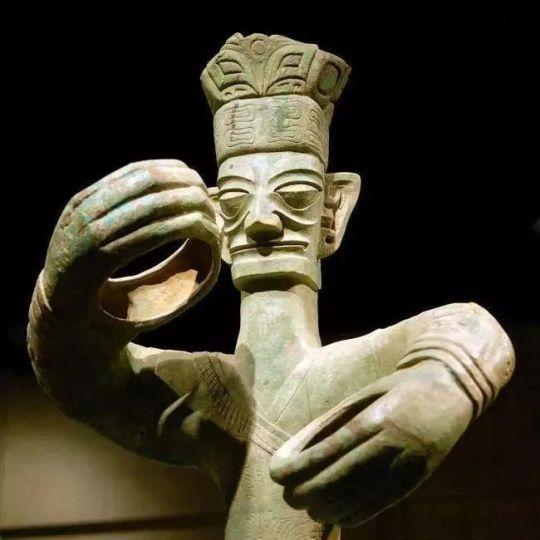
It's amazing, for what reason did the ancestors of Sanxingdui make these "handicrafts"?
这就很奇妙了,三星堆先民是出于什么原因造出了这些“手办”的呢?
Why is the ancient Shu civilization buried under the site of Sanxingdui so different from the civilization of the Middle Kingdom?
埋藏在三星堆遗址下的古蜀文明,又为什么会跟中原文明有如此大的差别?
ould this be a civilization independent of the Central Plains?
难道这是一个独立于中原的文明吗?
Everything still has to go back to the history of the ancient Shu state a thousand years ago to find out.
一切还得要回溯到千年前古蜀国的历史里,去一探究竟。
Legend has it that the first chief of the ancient kingdom of Shu named Cancong, ancient books record that he had a pair of peculiar "vertical eyes", eyes are not only particularly large, but also double protruding forward, extraordinary eyesight.
传说古蜀国的第一位首领名叫蚕丛,古书里记载,他有一双奇特的“纵目”,眼睛不仅特别大,还双双向前突出,视���非同一般。

Before the establishment of the ancient Shu Kingdom, Cancong led the Cancong tribe to live in the area of Minshan Mountain, where the terrain of the peaks and valleys, deep river valleys, people can only live by the mountains and caves, the conditions are very difficult.
在建立古蜀国以前,蚕丛率领着蚕丛氏部落生活在岷山一带,那里的地势峰峦叠嶂、河谷深切,人们只能依山凿洞而居,条件非常艰苦。
Then one day, he was patrolling the mountains and surprisingly, with his longitudinal eyes, he saw from afar that the Chengdu Plain was open and fertile for thousands of miles, which was perfect for living.
后来有一天,他在山间巡逻,竟然用自己的纵目远远看见成都平原地势开阔、沃野千里,非常适合居住。
After returning, Cancong immediately led the tribe to trek through the mountains and water, migrated to the Chengdu Plain, where the kingdom was established. Later, the ancestors of the tribe remembered Cancong and wished they could also have a pair of sharp eyes, so they made a bronze longitudinal eye mask specifically according to the appearance of Cancong, and gradually formed the unique eye cult of the ancient Shu people.
回来以后,蚕丛就立刻带领部落跋山涉水,迁徙到了成都平原,在此建国称王。 后来,部落先民感念蚕丛,又希望自己也能拥有一双目力超群的犀利眼睛,就专门按照蚕丛的样子,制作了一副青铜纵目面具,同时也逐渐形成了古蜀人独特的眼睛崇拜。
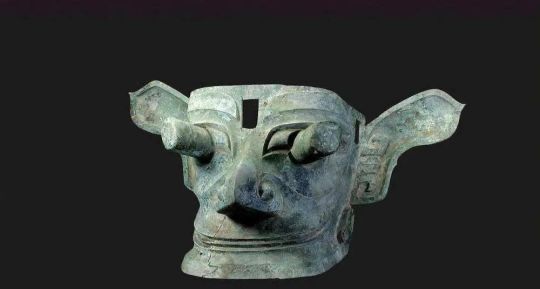
The mask is now on display at the Sanxingdui Museum and is one of the "six national treasures" of Sanxingdui.
这副纵目面具现在陈列于三星堆博物馆,是三星堆“六大国宝”之一。
It is majestic and imposing, so large that it took four or five people to lift it when it was unearthed, so you can imagine that it could not be worn.
它造型雄奇,威风凛凛,体积非常庞大,出土的时候需要四五个人才能合力抬起来,可想而知,这根本没法拿来佩戴。
A more likely scenario is that it was treated as an incarnation of the ancient Shu king Cancong Clump and placed in the center of some altar to be worshipped by the ancient Shu ancestors.
更有可能的情况是,它被当作古蜀王蚕丛的化身,摆在了某个祭坛中央,接受古蜀先民的祭拜。
In addition to the longitudinal eye mask, archaeologists have unearthed five eye-shaped ornaments, 71 eye-shaped bronze objects, and 33 eye bubbles in one site pit alone - not counting the various eye symbols on other artifacts.
除了纵目面具以外,考古工作者们光光在一个遗址坑里,就发掘了5件眼形饰、71件眼形铜器、33件眼泡——还没算上其他文物上各种各样的眼睛符号。
This shows how important eye worship was in the beliefs of the ancient Shu ancestors at that time.
可见当时在古蜀先民的信仰观念里,眼睛崇拜是一项多么重要的内容。
75 notes
·
View notes
Text
A staggering mythical beast statue has been extracted from a sacrificial pit in China delighting investigators who note that the 3,000-year-old piece of art looks ‘cutting edge, even today’.
46 notes
·
View notes
Text
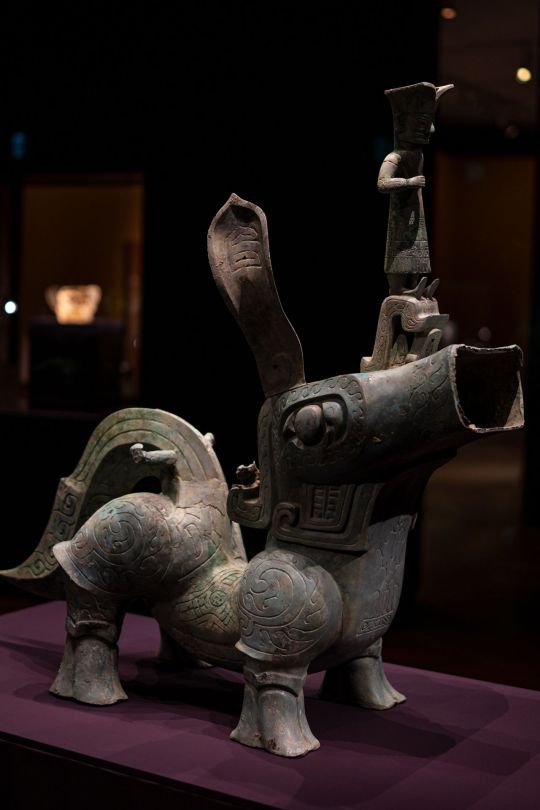
The Shu kingdom, which emerged in the Sichuan basin during the Bronze Age, is believed to have developed independently of the Yellow River Valley societies traditionally considered the cradle of Chinese civilization. Its inhabitants created exquisitely crafted bronze, jade, gold and ceramic objects, depicting fantastical beasts, kings, gods and shamans with bulging eyes and enlarged ears.
1,000 years older than the terra cotta army.
2 notes
·
View notes
Text
Hi Producer (正好遇见你) Infodump
Disclaimer: I have no idea about the accuracy of the information shared in the drama, I'm merely transcribing for future reference purposes. Proceed with caution!
.
Ep 28-29: Bronzeware
Traditional Chinese Bronzeware has a history of over 5,000 years. Although it's not the earliest place of origin for bronze in the world, it has made a mark in the history of bronzeware in the world for its craftsmanship.
During the Xia, Shang, and Zhou dynasties, bronze was used mainly for ceremonial instruments and military weapons, and bronze craftsmanship rose to its peak, producing countless stunning works of bronze. This period was also known as the Bronze Age.

.
Bronze Sun Wheel
From Sanxingdui. Over 3,000 years old.

.
Dragon Spout Vessel, Bronze Lamp With a Crane on Turtle Replica
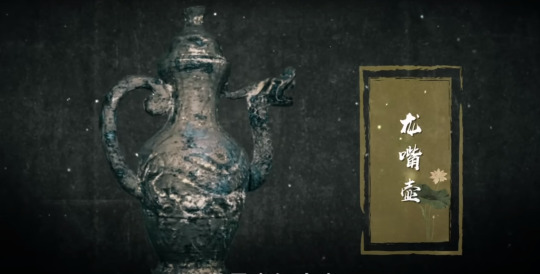

.
Lotus and Crane Rectangular Hu - Crane from Henan, Four-goat Square Zun
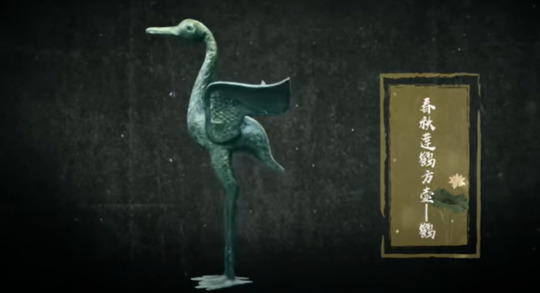

During the Shang and Zhou dynasties, pigs, cattle, and goats were used as sacrificial offerings. Among bronze drinkware, vessels designed in the form of goats came to be. Historians believe that the horns and dragon heads of the Four-goat Square Zun were first cast separately and then arranged on the exterior before being cast as a whole. The pinnacle of the traditional clay casting method. It is ranked third among the ten national treasures.
.
Jin State Western Zhou Bronze Bird Zun
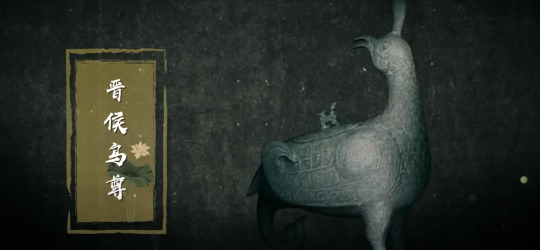

From Jin state, 3,000 years old. An early mid-Western Zhou temple ritual vessel. It is designed in the form of a phoenix looking back. The large bird looks at its nestling, covered in patterns. The phoenix tail and elephant trunk act as support. An intricate piece of art with a peculiar shape. Because it was excavated close to a tunnel that was dug without proper permits, it was already broken into more than 100 fragments when it was discovered. It took over a long year of careful restoration before it was brought into the public eye.
.
Ding
The development of Ding, the cauldron- it used to be a vessel for storing and cooking meat. Then came the legend of the Nine Tripod Cauldrons; Jizhou, Yanzhou, Yuzhou, Jingzhou, Qingzhou, Yangzhou, Xuzhou, Yongzhou, Liangzhou and it gradually became a symbol of state and power.
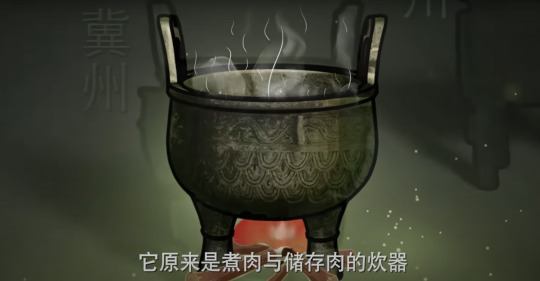

.
Bronze Quadrangular Li with an Amputated Slave
It's cookware like Ding. The shape is also quite similar. But Li is hollow and three-legged. According to the "Rites of Zhou", the eunuchs guard the palace, while the amputee guards the garden. The man with a crutch at the front gate here probably committed a crime and was punished with amputation and was therefore sentenced to guard the nobles' garden.
Did ancient people make cookware like this to raise awareness and educate the general public about the law? You can look at it this way if you want or not.

Looking at the shape of the ware, food can be placed into the upper level to be cooked, while the lower level is used to burn coal. The smoke emitted can be smoothly discharged through the windows on the left and right and through the hollowed-out area at the back.
Traditionally, they believe that a Ding is used to cook meat, while a Li is used to cook grains. (The FL compares the Li to a Hot Pot and then a Rice cooker lol).
.
Gui with a Beast Face Pattern Replica
It's for storing millet and grains. Bowl. Flared mouth and rounded belly are distinctive features of Gui.
The Zhou rites have very strict rules for the use of Dings and Guis by different social classes.

.
Bronze Sword Replica, Bronze Ax of Fu Hao Replica


Dagger-Ax of Fu Hao Replica, Dagger-Ax of Prince in Wu State Replica

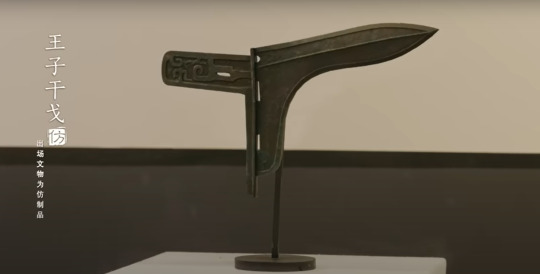
Bronze Dagger-Ax Replica
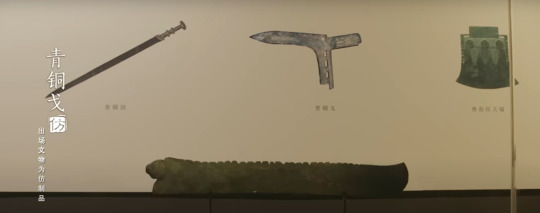
岂曰无衣?与子同袍。王于兴师,修我戈矛。与子同仇。
How can you say we are without armor? Our camaraderie remains. To battle, we shall go with you. Our dagger-axes and spears are sharpened. We shall fight with you!
岂曰无衣?与子同泽。王于兴师,修我矛戟。与子偕作。
How can you say we are without armor? Our comradeship remains. We shall fight with you! Our lances and spears are sharpened. To the battlefield, we shall enter with you.
岂曰无衣?与子同裳。王于兴师,修我甲兵。与子偕行。
How can you say we are without armor? Our comradery remains. We shall fight with you! Our weapons are sharpened. Together, we go to war!
——《诗经·秦风·无衣》 From Shi jing/Book of Songs. Wú Yī 無衣 (commonly translated as "No clothes (no armor)"
(A Song from the state of Qín 秦 [modern Shǎanxī 陕西 and Gānsù 甘肃])
.
Rites and Music
China is a land of etiquette, complex rituals and music since before 3,000 years. The Zhou people classified the 18 musical instruments used for court music into eight categories based on their materials, which were clay, gourd, skin, wood, stone, metal, silk, and bamboo. They believed that the eight tones were the only way to achieve the unity of heaven and man.
youtube


Bianzhong is a large percussion instrument cast in bronze. Bianzhong existed in China as early as the Western Zhou, the first country in the world to make and use this instrument. Many cultural attractions use it to hoodwink tourists. It's rarely used in contemporary performances.
youtube
There has been a revival of Chinese music in recent years. But on the whole, Western music is still more popular. Merging these different musical approaches can bring marvelous results.
.
Timestamped documentary section:
youtube
.
More Hi Producer posts
#cdrama#chinese drama#正好遇见你#Hi Producer#chinese history#bronzeware#sanxingdui#court music#traditional chinese musical instruments#bianzhong#Chinese bronzeware
3 notes
·
View notes
Text

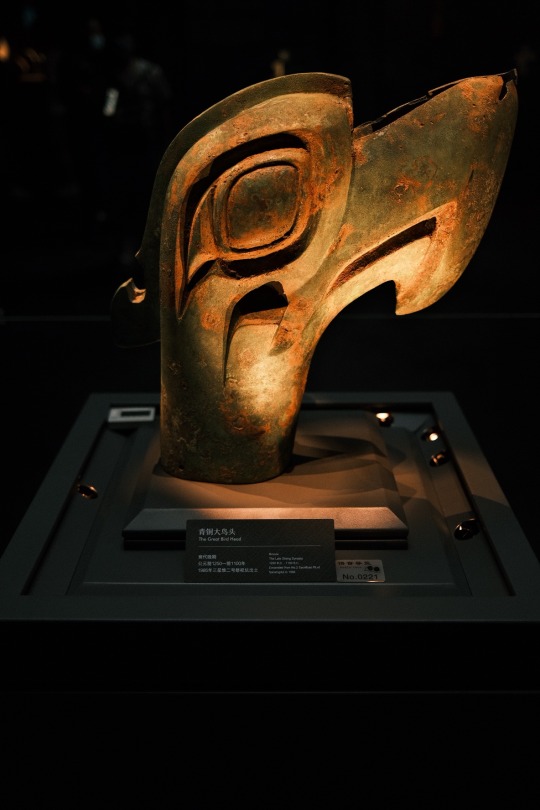



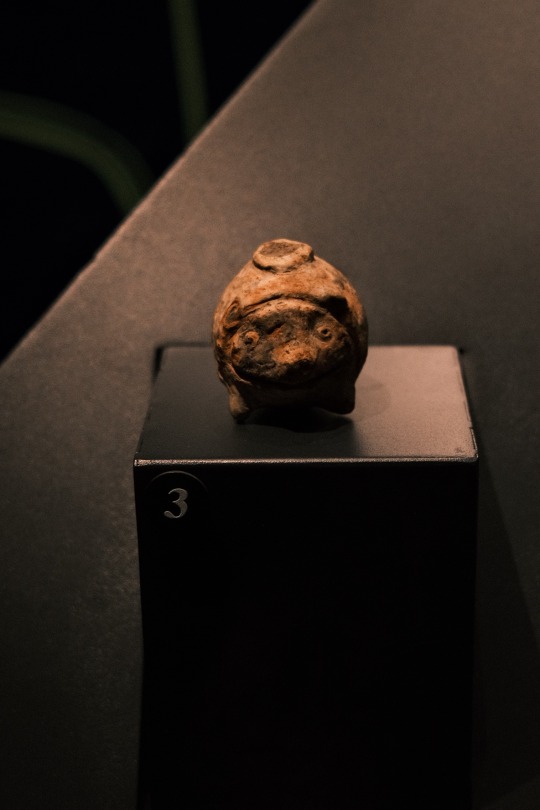
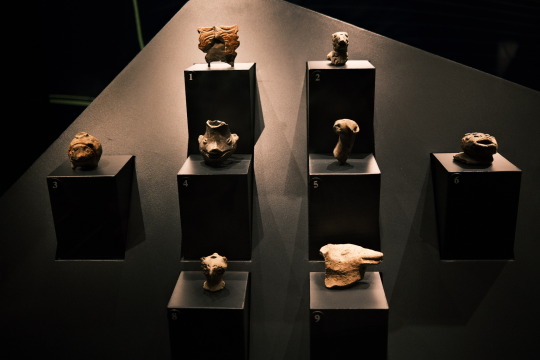

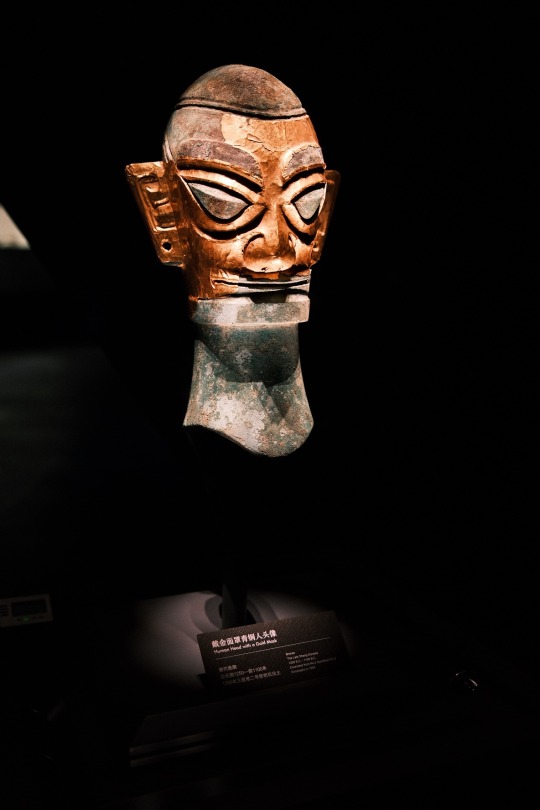
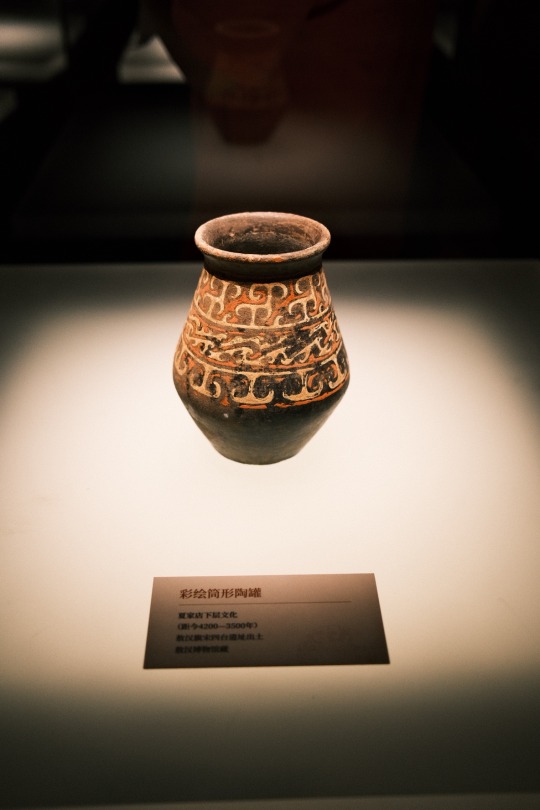
sanxingdui museum
很开心的一天~观摩了古代人的生活方式以及对生活的思考🧐
一共参观了四个场馆,天气炎热但是非常有意义🫡
13 notes
·
View notes
Text
I love the graphic nature of these artworks. Beautiful.
5 notes
·
View notes
Text
SANXINGDUI: A GLIMPSE INTO THE ENIGMATIC BRONZE AGE CIVILIZATION OF CHINA
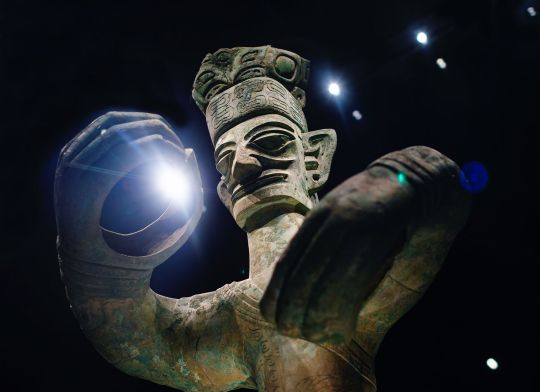
View On WordPress
#ancient China#archaeological discovery#archaeological research#Atlantis connection#Bronze Age#bronze casting#bronze masks#Chinese history#cultural center#extraterrestrial influence#gold relics#jade artifacts#lost civilization#political capital#ritual practices#Sanxingdui#Shanghai exhibition#Sichuan Province#Stars Over China#trade hub
1 note
·
View note
Text
The secrets may unveil themselves behind the magic mask unearthed in Sanxingdui heritage site dated back to 5000 years ago!
0 notes
Text
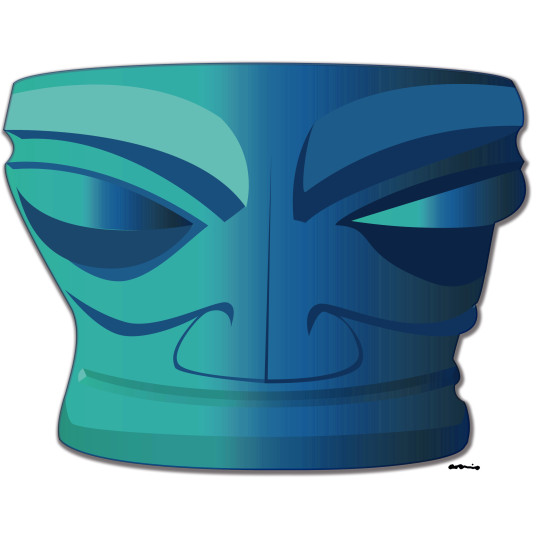
Vector graphics "SANXINGDUI FACE" (Arkadiusz Miodek)
#graphic#vectorgraphic#art#sanxingdui#sanxingduiface#face#mask#arkadiuszmiodek#aremio#aremioart#amiod#sztuka#arekmiodek#arek#arkadiusz
1 note
·
View note
